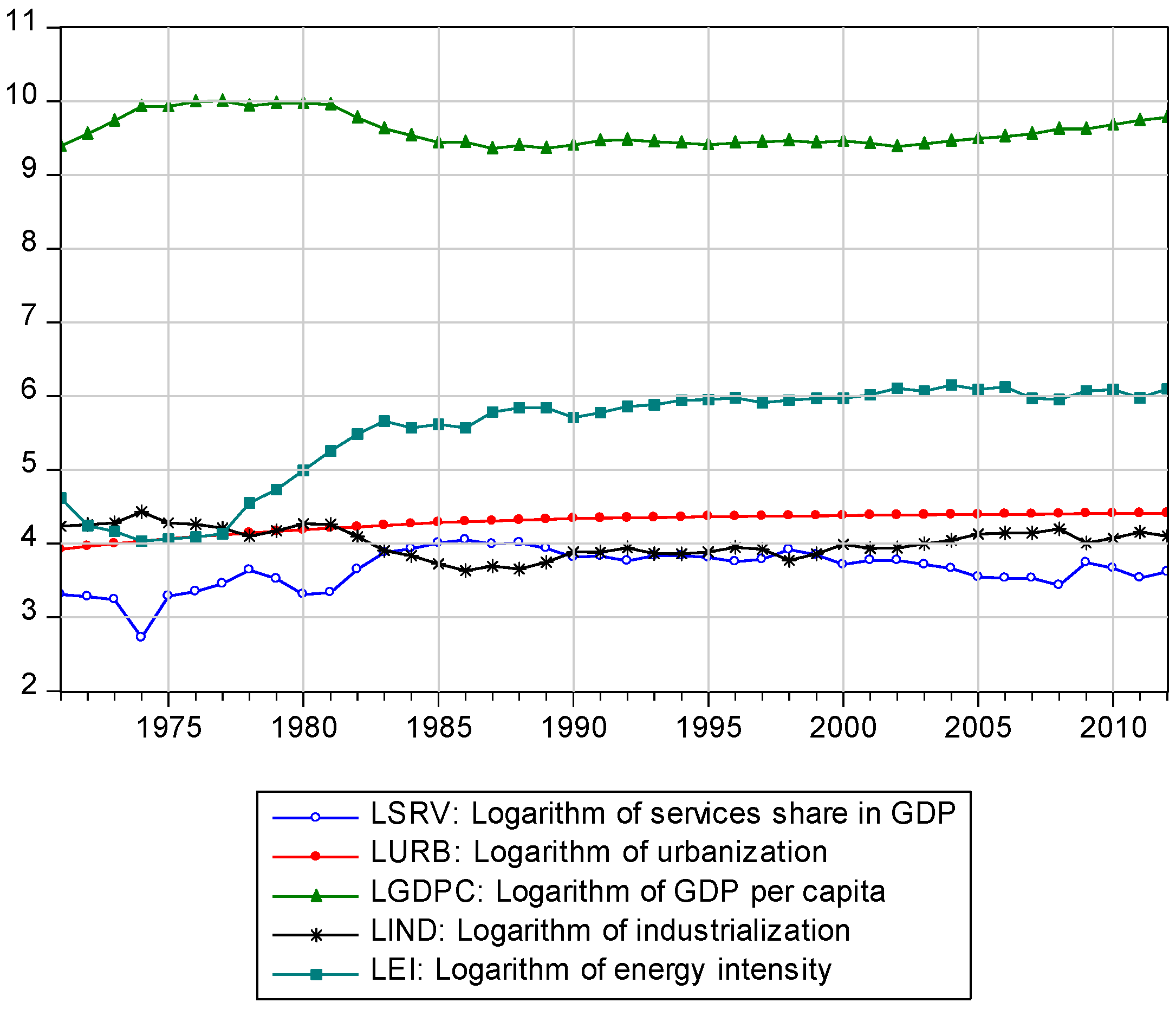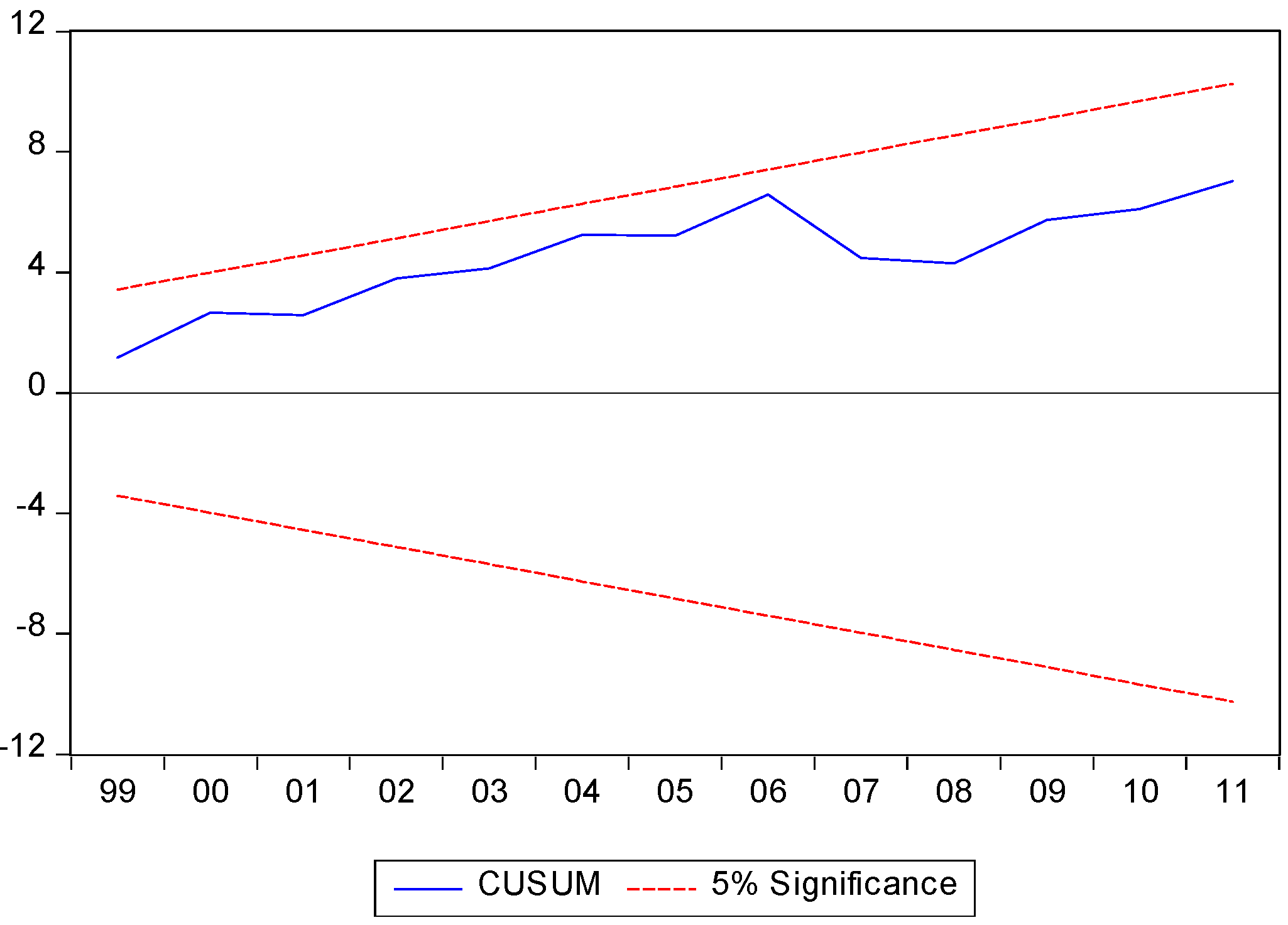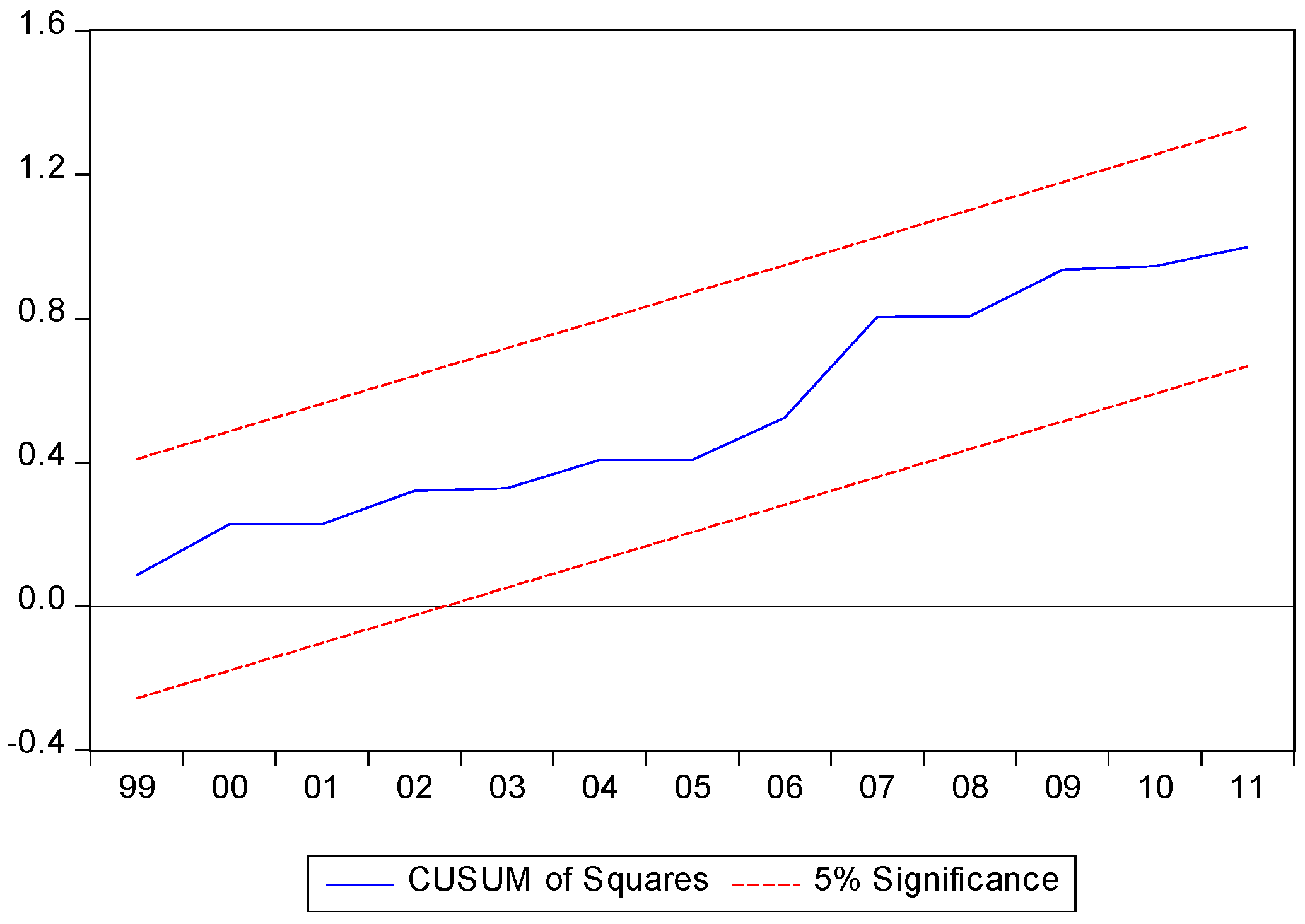2.1. Impact of Urbanization, Industrialization, and Income on Energy Use
Many studies have shown that urbanization can affect energy use or energy intensity through several channels [
4,
16,
17,
21,
23]. First, urban infrastructure needs to consume more energy through the expansion of economic activities. In addition, urbanization leads production to shift from agriculture that is less energy-intensive to manufacturing industries, which are more energy-intensive. Second, modern buildings operate with more energy consumption equipment (e.g., refrigerators and air conditioning). Third, in urbanized cities, there is more motorized traffic and congestion, which leads to more energy use [
2,
15,
16,
21,
23].
At the same time, technological mechanisms (e.g., energy-saving buildings, efficient home appliances, central heating systems, fuel-efficient transportation,
etc.) lead to reduced energy consumption within buildings and transportation in urban cities [
17]. In addition, a high population density in urban cities allows for economies of scale in urban public infrastructures through the reduction of private car use and travel distances, and the reduction in losses of electricity supply, thus causing a reduction of energy consumption [
17]. In addition, urbanization can afford some economies of scale to decrease energy consumption mainly in public services (e.g., health and primary education), which are equally provided to urban (more populated) and rural regions (less populated). We call this energy-saving effect [
4,
17].
Globally, the impact of urbanization on energy use or energy intensity can be positive or negative because urbanization leads to the expansion of economic activity through a higher concentration of consumption and production, but it also leads to economies of scale and provides an opportunity for increases in energy efficiency.
Industrialization leads in general to an increase in energy consumption because industrial activities (e.g., petroleum refining, primary metals, chemicals, paper and allied products, and manufacturing) consume more energy than traditional agricultural activities or textile industries [
16,
21,
24]. In addition, the industrialization promotes the urbanization process through the migration of labor force from agricultural regions to the urban manufacturing cities [
25].
It is also shown that energy intensity declines as income increases [
19]. This is explained by the structural change of the economy from pre-industrialization stages based on agriculture (more energy-intensive) to post-industrialization stages based on services (less energy-intensive), and technological progress leads to increases in energy efficiency and to the usage of substitute materials that are less energy-intensive.
In addition, the increase in income and the technological development have led economic systems to switch from a system based on traditional biomass to a system based on fossil fuels [
17]. The rapid urbanization and industrialization in many regions in the world facilitates and accelerates the energy transition, which leads to more energy use and hence more problems of environmental degradation. However, it is unclear whether the influence of urban cities expansion on energy consumption and carbon dioxide emissions varies due to different levels of development of an economy or income [
13].
2.3. Review of Empirical Studies
The impact of urbanization on energy use has been extensively studied in the existing literature. We are limited here to econometric studies. Many previous studies (e.g., [
2,
3,
4,
5,
6,
8,
9,
10,
11,
17,
27] found that urbanization positively affects energy consumption. Jones [
2] analyzed the effect of urbanization on energy use by estimating a regression linear model for 59 developing countries during the year 1980. He found that urbanization positively affects energy consumption, and the urbanization elasticity of energy use varied from 0.35 to 0.48. By using a panel data set of developed and developing countries over the period 1965–1987, Parikh and Shukla [
4] found similar results to Jones [
2]. Their findings showed that urbanization has a significant and positive impact on energy use; and urbanization elasticity of energy use is in the range of 0.28 to 0.47. By estimating a linear regression model by the ordinary least squares (OLS) method, Burney [
3] also found a positive impact of urbanization on electricity consumption per capita using cross-sectional data for the year 1990 for 93 countries. Moreover, by using an error correction model Holtedahl and Joutz [
5] found that urbanization positively affects residential energy consumption in Taiwan in both the short term and the long term over the period 1956–1995. They explained their findings by the easy access to electricity in urban cities. By studying a group of advanced European countries and employing the stochastic impacts by regression on population, affluence, and technology (STIPAT) model, York [
6] also found a positive impact of urbanization on energy use. His finding showed that urbanization elasticities are in the range of 0.29 to 0.56. By using an econometric time series technique based on the autoregressive distributed lag (ARDL) bounds testing to cointegration approach, Liu [
27] found a long-term relationship between energy consumption, GDP, urbanization, and population in China over the period extended from 1978 to 2008. The results of the Granger causality test indicated that urbanization causes energy consumption in both the long term and short term. In addition, by using the factor decomposition model, Liu [
27] found that the contribution share of urbanization on energy consumption is positive but is decreasing due to energy efficiencies. Poumanyvong
et al. [
10] studied the impact of urbanization on road energy consumption for a group of low-, middle-, and high-income countries during the period of 1975 to 2005 by using the STIRPAT model. They found that urbanization has a positive impact on road energy use in all countries, but the magnitude of its influence is greater in high-income countries group than in the other country groups. Shahbaz and Lean [
8] studied the causal relationships between urbanization, energy consumption, economic growth, industrialization, and financial development in Tunisia over the period of 1971 to 2008 by employing the ARDL bounds testing to cointegration approach and the Johansen multivariate cointegration approach. They found the existence of long-term relationship among energy consumption, economic growth, financial development, industrialization, and urbanization in Tunisia. In addition, they found that Tunisia’s urbanization positively and significantly affects energy consumption in the long term, whereas its impact is insignificant in the short term. A 1% increase in Tunisia’s urban population leads to an increase of 0.9% in its energy consumption in the long term. Using the same methodology employed by Shahbaz and Lean [
8], Adom
et al. [
9] found a positive impact of urbanization on electricity consumption in Ghana over the period 1975–2005. Al-mulali
et al. [
11] studied the relationship between energy consumption, urbanization, and CO
2 emissions for a panel of the Middle East and North Africa (MENA) countries over the period 1980–2009. They found that the three variables are cointegrated and there is a long-term bi-directional positive relationship between urbanization, energy consumption, and CO
2 emissions. The authors suggested that MENA countries should slow the rapid increase in urbanization in order to reduce energy consumption and CO
2 emissions in the region. More recently, Ma [
17] investigated the impact of urbanization on energy intensity, electricity intensity, and coal intensity in China using dynamic models and panel datasets at the provincial level over the period 1986–2011. The empirical findings revealed that China’s urbanization positively affects energy intensity and electricity intensity in the long term, but it does not influence coal intensity. From these results, the author concluded that energy policies linked to the urbanization process should be province-specific.
On the other hand, some studies found that urbanization negatively influences energy use (e.g., [
12,
14,
28]). For example, by estimating an environmental Kuznets curve (EKC) semi-log model for a group of 23 OECD countries over the period 1960–2000, Liddle [
12] found that the impact of urbanization on road energy consumption is negative. Using an OLS regression analysis, Ewing and Rong [
28] found that urbanization negatively affects residential energy use in the United States. Using panel data models for 94 countries over the period covering the years from 1981 to 2007, Fang
et al. [
14] found that the impact of urbanization on total energy consumption is negative for high-income countries but not significant for low-income countries.
Finally, some other studies found mixed results (e.g., [
7,
13,
15,
29,
30,
31]). By using annual series data from 1968 to 2005, Halicioglu [
29] studied the relationship between urbanization, residential energy use, energy prices, and GDP for Turkey by estimating dynamic models based on the ARDL bounds testing for cointegration approach. The author found that urbanization Granger causes residential energy use in the long term but not in the short term. Two years after, Mishra
et al. [
7] studied the relationship between urbanization, GDP, and energy consumption for a group of Pacific Island countries over the period of 1980 to 2005. They found that increases in urbanization lead to increases in energy consumption in the countries of Fiji, French Polynesia, Samoa, and Tonga, whereas urbanization negatively affects energy consumption in New Caledonia.
Poumanyvong and Kaneko [
13] investigated the impact of urbanization on energy use and CO
2 emissions by estimating a STIPAT model for a sample of 99 countries over the period 1975–2005. Their results revealed that the effect of urbanization on energy use depends on the stages of development (income classes). Urbanization positively affects energy consumption in the countries with middle and high incomes, or it negatively affects energy use in the low-income group. The impact of urbanization on CO
2 emissions is positive for all income groups. In addition, the impact of industrialization on energy use is positive in the countries with low and middle incomes. Krey
et al. [
30] used integrated assessment models to analyze the impact of urbanization on residential energy use in China and India. They found that urbanization does not affect residential energy use directly, but the relationship between urbanization and energy use depends upon how labor productivity affects economic growth. Studying the same countries as Krey
et al. [
30], O’Neill
et al. [
31] used a computable general equilibrium model to investigate the impact of urbanization of energy. They found that the direct effect of urbanization on energy consumption is not that strong and much of the impact of urbanization on energy use comes through the impact that an increased labor supply has on economic growth. Wang [
15] found that urbanization reduces residential energy use because of the economies of scale and technological advances associated with urbanization, whereas the growth of economic activities caused by the urbanization process leads to an increase in energy consumption in China.
Even though there are many studies investigating the effect of urbanization on energy use, much less has been done on the influence of urbanization on energy intensity (e.g., [
16,
20,
21,
24,
32]). The pioneering work of Jones [
21] was the first that analyzed the impact of income, urbanization, and industrialization on energy intensity in 59 developing countries for the year 1980. He found that the different long-term elasticities of income, urbanization, and industrialization are equal to 0.77, 0.35 and 1.35, respectively. Galli [
32] estimated the impact of income on energy intensity in ten Asian countries over the period 1973–1990. The empirical results showed that income negatively affects energy intensity in the long term. Samouilidis and Mitropoulos [
24] found long-term elasticities of industrialization to energy intensity in the range of 0.90 to 1.96 and short-term elasticities in the range of 0.17 to 0.46 for the case of Greece. Sadorsky [
16] analyzed the impact of income, industrialization, and urbanization on energy intensity for a group of 76 developing countries over the period 1980–2010 by using heterogeneous panel regression techniques. He found negative income elasticities and positive industrialization elasticities of energy intensity, whereas the effect of urbanization is mixed. When considering energy intensity as dependent variable, the impact of income variable reflects only the technique effect and not the scale effect. Elliot
et al. [
20] studied the influences of urbanization and industrialization on energy intensity in China using a group of 29 provinces over the period 1997–2010. Their findings showed that industrialization is the overwhelming contributor to Chinese energy intensity, with elasticities ranging from 0.62 to 0.66 in the short term and slightly higher in the long term. This confirms that China has experienced industry-led economic development. The rapid expansion of energy-intensive sectors has had a serious effect on other energy sectors.












